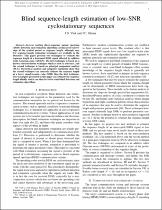JavaScript is disabled for your browser. Some features of this site may not work without it.
- ResearchSpace
- →
- Research Publications/Outputs
- →
- Journal Articles
- →
- View Item
| dc.contributor.author |
Vlok, JD

|
|
| dc.contributor.author |
Olivier, JC

|
|
| dc.date.accessioned | 2014-08-25T10:17:01Z | |
| dc.date.available | 2014-08-25T10:17:01Z | |
| dc.date.issued | 2014-06 | |
| dc.identifier.citation | Vlok, J.D and Olivier, J.C. 2014. Blind sequence-length estimation of low-SNR cyclostationary sequences. IET Communications, vol. 8(9), pp 1578-1588 | en_US |
| dc.identifier.issn | 1751-8628 | |
| dc.identifier.uri | http://ieeexplore.ieee.org/stamp/stamp.jsp?tp=&arnumber=6830057 | |
| dc.identifier.uri | http://hdl.handle.net/10204/7626 | |
| dc.description | Copyright: 2014 Institution of Engineering and Technology (IET). This is the post print version. The definitive version is published in IET Communications, vol. 8(9), pp 1578-1588 | en_US |
| dc.description.abstract | Several existing direct-sequence spread spectrum (DSSS) detection and estimation algorithms assume prior knowledge of the symbol period or sequence length, although very few sequence-length estimation techniques are available in the literature. This paper presents two techniques to estimate the sequence length of a baseband DSSS signal affected by additive white Gaussian noise (AWGN). The first technique is based on a known autocorrelation technique which is used as reference, and the second technique is based on principal component analysis (PCA). Theoretical analysis and computer simulation show that the second technique can correctly estimate the sequence length at a lower signal-to-noise ratio (SNR) than the first technique. The techniques presented in this paper can estimate the sequence length blindly which can then be fed to semi-blind detection and estimation algorithms. | en_US |
| dc.language.iso | en | en_US |
| dc.publisher | Institution of Engineering and Technology (IET) | en_US |
| dc.relation.ispartofseries | Workflow;12966 | |
| dc.subject | Direct-sequence spread spectrum | en_US |
| dc.subject | DSSS | en_US |
| dc.subject | Additive white Gaussian noise | en_US |
| dc.subject | AWGN | en_US |
| dc.title | Blind sequence-length estimation of low-SNR cyclostationary sequences | en_US |
| dc.type | Article | en_US |
| dc.identifier.apacitation | Vlok, J., & Olivier, J. (2014). Blind sequence-length estimation of low-SNR cyclostationary sequences. http://hdl.handle.net/10204/7626 | en_ZA |
| dc.identifier.chicagocitation | Vlok, JD, and JC Olivier "Blind sequence-length estimation of low-SNR cyclostationary sequences." (2014) http://hdl.handle.net/10204/7626 | en_ZA |
| dc.identifier.vancouvercitation | Vlok J, Olivier J. Blind sequence-length estimation of low-SNR cyclostationary sequences. 2014; http://hdl.handle.net/10204/7626. | en_ZA |
| dc.identifier.ris | TY - Article AU - Vlok, JD AU - Olivier, JC AB - Several existing direct-sequence spread spectrum (DSSS) detection and estimation algorithms assume prior knowledge of the symbol period or sequence length, although very few sequence-length estimation techniques are available in the literature. This paper presents two techniques to estimate the sequence length of a baseband DSSS signal affected by additive white Gaussian noise (AWGN). The first technique is based on a known autocorrelation technique which is used as reference, and the second technique is based on principal component analysis (PCA). Theoretical analysis and computer simulation show that the second technique can correctly estimate the sequence length at a lower signal-to-noise ratio (SNR) than the first technique. The techniques presented in this paper can estimate the sequence length blindly which can then be fed to semi-blind detection and estimation algorithms. DA - 2014-06 DB - ResearchSpace DP - CSIR KW - Direct-sequence spread spectrum KW - DSSS KW - Additive white Gaussian noise KW - AWGN LK - https://researchspace.csir.co.za PY - 2014 SM - 1751-8628 T1 - Blind sequence-length estimation of low-SNR cyclostationary sequences TI - Blind sequence-length estimation of low-SNR cyclostationary sequences UR - http://hdl.handle.net/10204/7626 ER - | en_ZA |






